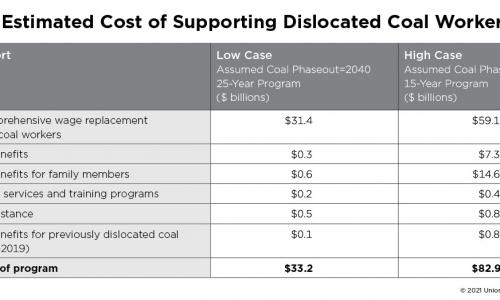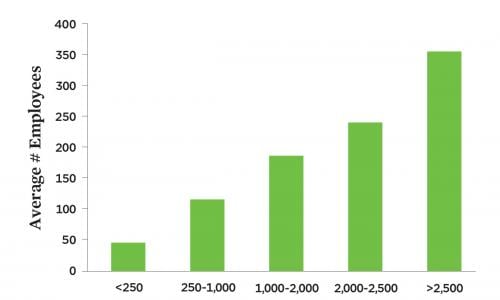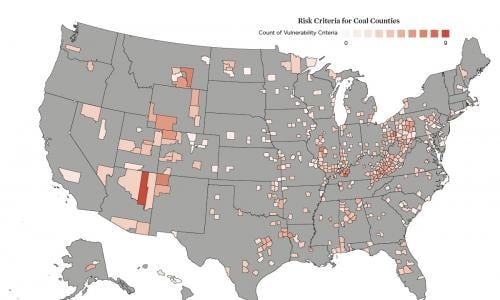Analysis by the Union of Concerned Scientists (UCS) and the Utility Workers Union of America (UWUA) finds that, not only it is possible to support coal workers in the shift to a low-carbon economy, but these comprehensive policies are affordable.
UCS and UWUA estimated the number of coal miners and coal-fired power plant workers at risk of losing jobs before reaching age 65 as the coal industry declines, and identified the number of US counties at risk due to their direct link to coal.
Comprehensive support for these workers would include five years of wage replacement, health coverage, continued employer contributions to retirement funds or pension plans, and tuition and job placement assistance.
In total, the analysis finds these supports would cost roughly between $33 billion over 25 years and $83 billion over 15 years—a fraction of the trillions of dollars of needed investments in the energy system in coming decades as we shift to a low-carbon economy.
As the energy mix changes—rather than offer false hope for reinvigorated coal markets—we must plan thoughtfully and offer support to the workers and communities that have sacrificed so much to build this country.
Supporting the Nation’s Coal Workers and Communities in a Changing Energy Landscape
This is a condensed, online version of the report. For all figures, references, and the full text, please download the PDF.
The shift to a low-carbon economy has proceeded largely without thoughtful plans or preparation for the workers and communities that have sustained the US economy for more than a century. The economic upheaval resulting from the dramatic job losses in the coal industry over the last decade has uprooted families, deepened economic anxiety, and left community leaders scrambling to keep schools open and social services in place. And the trend is set to continue: many more coal workers and communities are facing the same fate without intentional policies to address these changes.
As part of this shift, the nation must support coal workers in finding new career paths and help coal communities recover from the economic losses stemming from coal’s decline (see box). This will require long-term individual supports and benefits, long-term investments in community infrastructure, empowering local leadership to drive place-based solutions, and ensuring that the legacy of coal mines and coal-fired power plants is fully remediated. These elements are critical to a fair, just, and equitable move to low-carbon energy; are urgently needed; and must be sustained over time.
Ultimately, broader changes to our energy systems will impact a larger swath of fossil fuel–dependent workers and communities as we drive toward decarbonizing the economy by 2050. This policy brief focuses on coal-dependent workers because they have faced economic disruption over the past decade and are imminently threatened by the shift to low-carbon energy in the near term.
But fortunately, there are solutions. New analysis by the Union of Concerned Scientists and the Utility Workers Union of America finds both that it is possible to support coal workers in the transition and that these comprehensive policies are affordable. Indeed, relative to the federal response to the Great Recession in 2008–2009 and the COVID-19 pandemic of 2020–2021, as well as the scale of investments needed to decarbonize our economy by 2050, investing in the nation’s coal workers comes with a relatively small price tag. Approximately 89,875 coal workers were employed in the United States in 2019. The cost of providing a comprehensive set of supports to the portion of these workers who will face job losses before reaching retirement age represents a tiny fraction of the estimated $2.5 trillion in additional capital investments in all energy sectors by 2030 that would be needed to reach net-zero emissions by 2050 (Larson et al. 2020). We estimate that the cost of these supports will range from $33 billion over 25 years to $83 billion over 15 years.
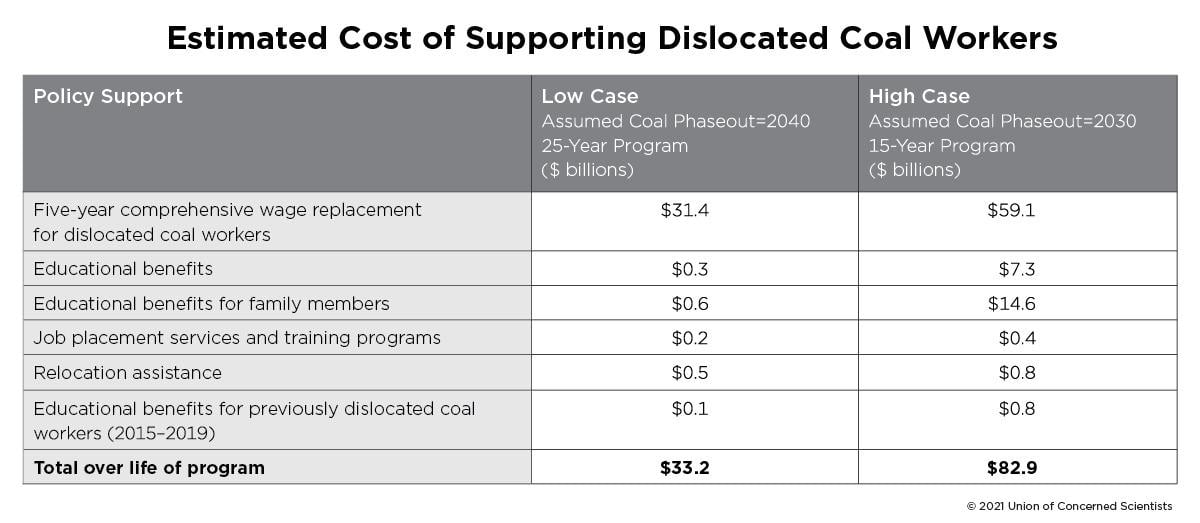
cases (assumptions are outlined in the technical appendix). A primary driver of the costs is the assumed length of the program, which would
extend five years beyond the year when the last worker exited the industry. As discussed in the methodology section, the shorter time period in
the high case means that more workers would require assistance because fewer would reach retirement age during the life of the program.
Multiple overlapping economic crises
The federal government can and does leverage considerable resources in response to a crisis. In the wake of the Great Recession, the United States ultimately spent $831 billion through the American Recovery and Reinvestment Act (CBO 2012). The COVID-induced economic crisis that began in 2020 led to the steepest declines in economic activity and employment since the Great Depression in the 1930s (Wheelock 2020). In 2020 Congress appropriated $2.59 trillion in new spending in response to the pandemic (CRFB 2021; US Treasury Data Lab 2020), and President Biden signed a $1.9 trillion COVID-19 relief package in March 2021.
In coal country, the current economic crisis comes on the heels of a decade of massive job losses and the resulting economic upheaval, as well as generations of disinvestment. The shift away from coal has accelerated over the past decade. Coal-fired electricity fell from about 50 percent of the nation’s electricity generation in 2010 to about 20 percent in 2020. Cheap and abundant natural gas and steep reductions in costs of wind and solar have led to closures and fuel switching and have driven approximately 90 gigawatts of coal retirements from 2009 to 2019—nearly 29 percent of the 314 gigawatts online in 2009 (EIA 2012b; Bolinger 2020; Aramayo 2020; Storrow 2020; Stromsta 2020). In addition, many states are increasing their renewable electricity standards (Barbose 2021), and eight states plus the District of Columbia and Puerto Rico have adopted 100 percent carbon-free targets (Deyette 2019). Many utilities, including those that still rely on coal-fired electricity, have also made commitments to reducing emissions and increasing renewable electricity generation (Bird and Clevenger 2019).
In the coal mining sector, employment nationally fell from 91,611 in 2011 to 51,795 in 2016 (EIA 2012a; 2017). The job losses were centered in central Appalachia, but the economic pain is now being felt in western mines as well, as evidenced by the high-profile layoffs in Wyoming in 2019 (Erickson 2019). This acute decline in coal mining employment comes after a steady decrease in employment from increased mechanization beginning in the 1960s and the shift toward large mining operations in the West beginning in the 1980s, both of which led to increases in labor productivity over the latter half of the 20th century (Reis and National Journal 2013; Schweinfurth 2002).
The latest science underscores the urgency of addressing climate change. Limiting some of the worst impacts of climate change will require cutting global carbon dioxide (CO2) emissions by about 45 percent by 2030 and reaching net-zero CO2 emissions no later than 2050 (IPCC 2018). Recent studies show that achieving these targets will require increased deployment of low-carbon energy and would likely lead to a near phaseout of coal (Larson et al. 2020; SDSN 2020). Achieving this emissions trajectory will continue the trend toward low-carbon energy and the closures of coal-fired power plants before the end of their useful lives (Grubert 2020).
Importantly, however, the burden of meeting these emissions reductions targets should not fall disproportionately on the workers who have helped keep the lights on for generations—and with well-designed policies at all levels of government, we can ensure that workers and communities are not left behind. While jobs in wind and solar are growing quickly, these new jobs are often not being created in the places where existing fossil fuel jobs are being lost, nor do they offer commensurate pay, benefits, or union density. Intentional policies are needed to create economically equivalent job opportunities in specific geographies and to prepare workers for those new jobs Zabin et al. 2020), most of which will be outside of the energy sector.
Cost estimates for supporting dislocated coal workers
This analysis estimates the cost of providing a range of transitional support for coal miners and workers at coal-fired power plants who will likely lose their jobs before they reach age 65 (see Table 1, p. 4, and methodology section, p. 5). It focuses only on direct employment in coal mining and coalfired power plants, but indirect jobs in the manufacturing and transportation supply chains will also be impacted and in need of transition assistance (Pollin, Wicks-Lim, and Chakraborty 2020). Importantly, these calculations assume that job losses are spread evenly over time, but in practice these coal plant closures are likely to occur unevenly. Because of this, and because workers may want to avail themselves of these benefits before closures actually occur, policymakers should consider front-loading appropriations. Table 1 shows the low- and high-range estimates for the comprehensive set of supports needed to help workers either transition into retirement or find new economic opportunities (JTF 2020). These supports include the following.
- Five-year comprehensive wage and benefit replacement:
Five years allows individual workers time to plan and train for new career opportunities. Full wage and benefit replacement (or wage insurance) for all dislocated coal workers includes health care premiums and employer retirement contributions.1 Employer retirement contributions can come in the form of 401(k) plans or defined-benefit plans (pensions).2
- Educational benefits:
The educational benefits for returning World War II veterans had a profound impact (DOD 2019), and this benefit would, similarly, allow dislocated workers to access a wide range of educational opportunities that could include vocational school, certification programs, apprenticeships, or degrees at twoor four-year institutions of higher education.
- College education for family members:
Children of dislocated workers would also be eligible for educational benefits as a way to help break cycles of generational poverty, similar to how GI Bill educational benefits can be transferred to spouses and children in certain cases (VA 2013).
- Training programs and job placement services:
Dislocated workers would be presumed eligible for the Adult and Dislocated Worker Programs under the Workforce Innovation and Opportunity Act (WIOA) at the Department of Labor in order to train for new opportunities in their local areas.
- Additional support structures:
Workers would be able to access mental health and counseling services, as well as relocation allowances when appropriate in individual circumstances.3
Using estimates of the number of dislocated workers and the reported national average salary for both coal miners and non-nuclear power plant operators (see the methodology section below and the technical appendix, online at www. ucsusa.org/resources/support-coal-workers), we can then calculate the range of costs for supporting these workers as the coal industry declines (Probst and Burke 2019). Recognizing the significant job losses that have occurred in recent years, we also estimate the costs of offering educational benefits to a portion of workers who lost coal jobs over the last five years (between 2015 and 2019).
A down payment on a comprehensive solution
These rough estimates represent just one element of the comprehensive set of policies needed to help coal workers continue to support their families while preparing for new careers or job opportunities. For example, the Black Lung Disability Trust Fund, a critical mechanism for providing medical support to disabled miners and their families, is projected to be approximately $15 billion in debt by 2050 (GAO 2018). The insolvency problem exists even without considering the recent resurgence of the disease (Hall et al. 2019), or future liabilities due to coal company bankruptcies (GAO 2020), meaning that this is likely an underestimate of future benefit needs. The fund could be fixed with a mix of debt forgiveness and continued coal excise taxes (GAO 2018).
Importantly, our cost estimates do not represent the full range of investments needed to ensure that not only workers but also communities have a chance to recover from the decline of coal and diversify their economies (JTF 2020), and more research is needed to quantify the problems. For example, communities heavily dependent on tax revenue from coal plants or coal mines will need temporary support to ensure that fire, police, schools, and other social services continue to operate (Morris, Kaufman, and Doshi 2019), and these costs could be large. Communities will also need grants for assessing economic opportunities and planning for future development—likely coming through expanded grant programs in the various federal programs that were supported during the Obama administration’s POWER Initiative programs (Raimi et al. 2020; Cecire 2019) or new formula-based community development block grants for impacted communities.
Ensuring the cleanup of the legacy of coal extraction and combustion is a critical element needed to facilitate future economic development. Mine reclamation has been hamstrung by lax enforcement and the recent wave of coal bankruptcies, with more to come (Bruggers 2021; Moore 2020). The existing estimates of the cost of mine reclamation do not account for the expected shortfalls due to declining coal production and future coal bankruptcies when coal companies will attempt to shed their cleanup responsibilities (and likely succeed). Burning coal also creates toxic ash that often remains in large ponds or impoundments. Upwards of 90 percent of these ponds are leaking (Earthjustice 2020), and many are contaminating groundwater and drinking water (Frank and Maloney 2020). Finally, historical and ongoing air pollution from burning coal harms public health, particularly overburdened and underserved communities, whose residents are often people of color and have low incomes (Thind et al. 2019; Sergi et al. 2020; Johnston and Cushing 2020).
For all of these issues, we must ensure that coal companies and utilities are held liable for the costs to the greatest extent possible before saddling taxpayers with the bill.
Managing the shift away from coal-fired electricity—with proper planning, robust stakeholder engagement, and sustained funding—can lead to successful outcomes for workers, underserved communities, and local governments. Plant closures can also allow for redevelopment or repurposing of sites, facilitating new economic opportunities, job creation, and community engagement. Comprehensive cleanup can create significant local jobs (French 2020; 2019; NPRC and IBEW 2018), and cleaning up legacy issues such as contaminated groundwater will allow these communities to become places where people want to live and work. This will help improve health outcomes for communities and attract new residents and new businesses. Investments in infrastructure, especially broadband, will help drive new economic development.
The United States need not start from scratch—Germany and Canada have both adopted national comprehensive plans to manage the shift away from coal (TFJTCCPWC 2018; CGSCE 2019). States are beginning to lead the way, with New Mexico (Energy Transition Act 2019) and Colorado (JTAC 2020) enacting policies aimed at helping workers and communities dependent on the coal industry chart new paths.
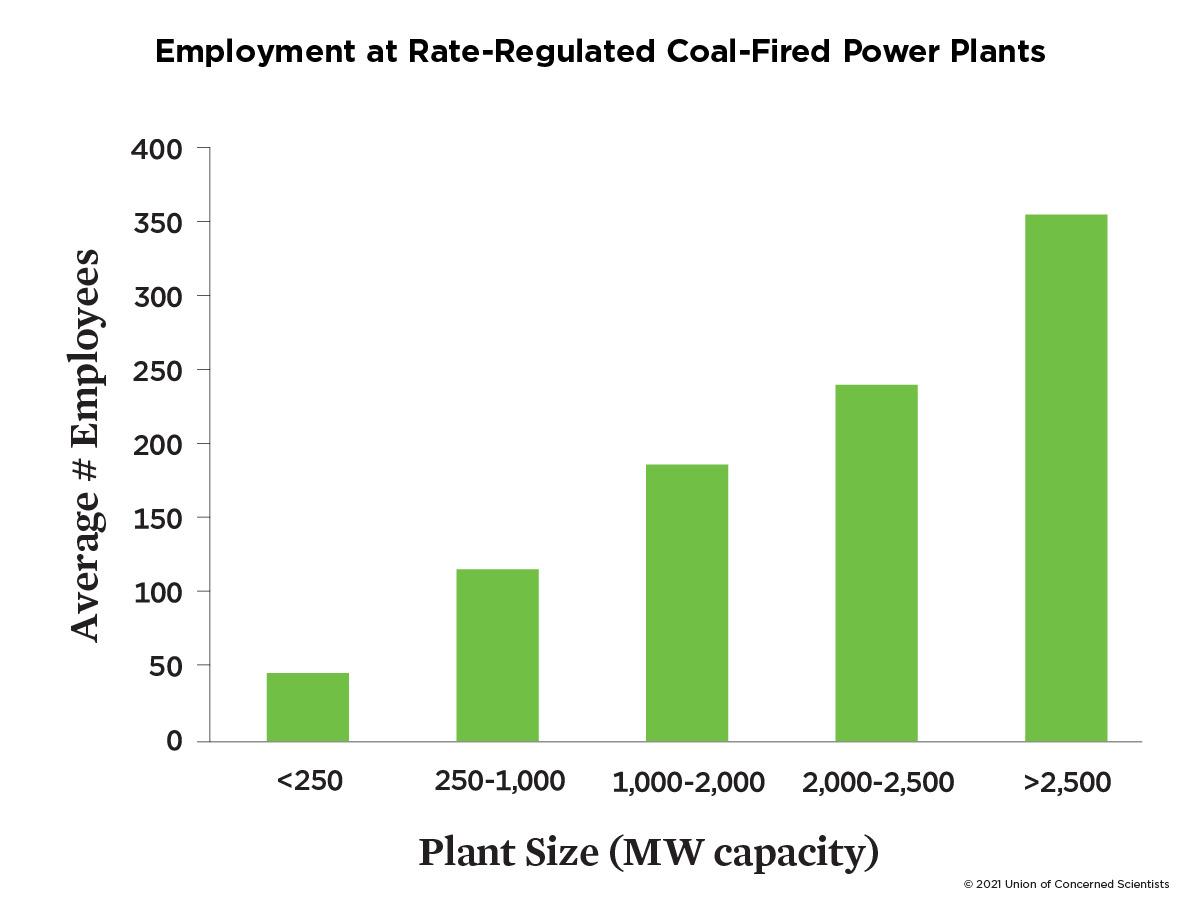
coal-fired power plants (see technical appendix).
Overview of methodology
Here we summarize the methodology for estimating the costs of worker supports and name some key assumptions. For a more complete description, please see the technical appendix.
Number of workers affected
First, we estimated the number of coal miners and coal-fired power plant workers employed in the United States. There were 52,804 individuals employed in coal mining in 2019 (EIA 2020). Notably, the data from the Energy Information Administration include some occupations such as yard workers and office workers, so this represents an overestimate (Pollin et al. 2019). For coal-fired power plants, however, employment data are available only for rate-regulated utilities for which annual reporting to the Federal Energy Regulatory Commission is required. Using these data, we calculated the average number of employees in five different sizes of power plants, defined in terms of plants’ generating capacity in megawatts (MW) (see Figure 1). These averages were then applied to the remainder of the non-reporting coal plants to estimate employment based on generating capacity. Using this method, we estimated that 37,071 people were employed at coal-fired power plants in 2019. For comparison, the 2020 U.S. Energy and Employment Report found 38,158 individuals employed at coal-fired utilities (NASEO and EFI 2019).
Smaller coal plants tend to be located in more urban areas and used only when electricity demand is high. Larger plants are often located in more rural areas where the utility may be the largest employer in town and the hundreds of lost jobs mark a significant hit to the local economy—this is reflected in our definition of counties most at risk from coal closures (see risk criteria below).
The basic assumption of this analysis is that all of these workers will lose their jobs as the coal industry declines. Importantly, however, not all of them will require assistance because workers who reach age 65 by the time they face layoffs will not be eligible for wage replacement or require retraining (Pollin, Wicks-Lim, and Chakraborty 2020; Pollin et al. 2019). A limitation of this analysis is that actual closure dates cannot be predicted with certainty, so we estimated the average annual number of dislocated workers based on the demographics of the workforce (see technical appendix). The analysis defines four criteria for defining a “coal county” based on existing jobs or recently lost jobs in coal mining or coal-fired power plants. A coal county, for the purposes of this analysis, is defined as:
- a county that reported coal production or coal mining employment in 2015 or 2019, 4 or
- a county that has faced the retirement of a coal-fired generating unit since the beginning of 2015 or where a coal-fired generating unit was in operation at the end of 2019.
Based on these criteria, we identified 462 counties (out of a total of 3,142 counties or county-equivalents in the United States) that have or had a direct connection to coal. We used 2015 as a starting date because that year marked a substantial uptick in retirements of coal-fired generating capacity, but this assumption excludes some coal mining counties that faced dramatic job losses during the downturn in the coal industry in the early part of the 2010s.
Risk criteria for counties' dependence on the coal industry
To evaluate the dependence of a county on the coal industry, we identified 10 risk criteria for the severity of the economic fallout from the decline of the industry. This is not intended to be an exhaustive list, and additional criteria and economic metrics could also be considered as part of future work.
For past coal mining counties:
-
Loss of at least 25 percent of mining jobs between 2015 and 2019, or
-
Decline of at least 10 percent in coal production from 2015 to 2019.
For current (2019) coal mining counties:
- At least 50 people employed by coal mines in 2019.
For counties with recent coal-fired power plant closures:
-
Retirement of at least 100 MW of coal-fired generating capacity between 2015 and 2019, inclusive,5 or
-
Retirement of at least 100 MW of coal-fired generating capacity in 2020.
For counties with operating coal-fired power plants:
-
At least 50 people employed at coal-fired power plants in 2019, or
-
Announced early retirement of at least 100 MW of coalfired generating capacity by the end of 2030.
For any coal county:
-
Number of coal jobs as a fraction of population is more than twice the average of all coal counties,6 or
-
The five-year average unemployment rate is higher than the national average, or
-
The five-year average poverty rate is higher than the national average.
These 10 risk criteria provide an initial look at which counties have been and will be most affected by the decline of the coal industry.
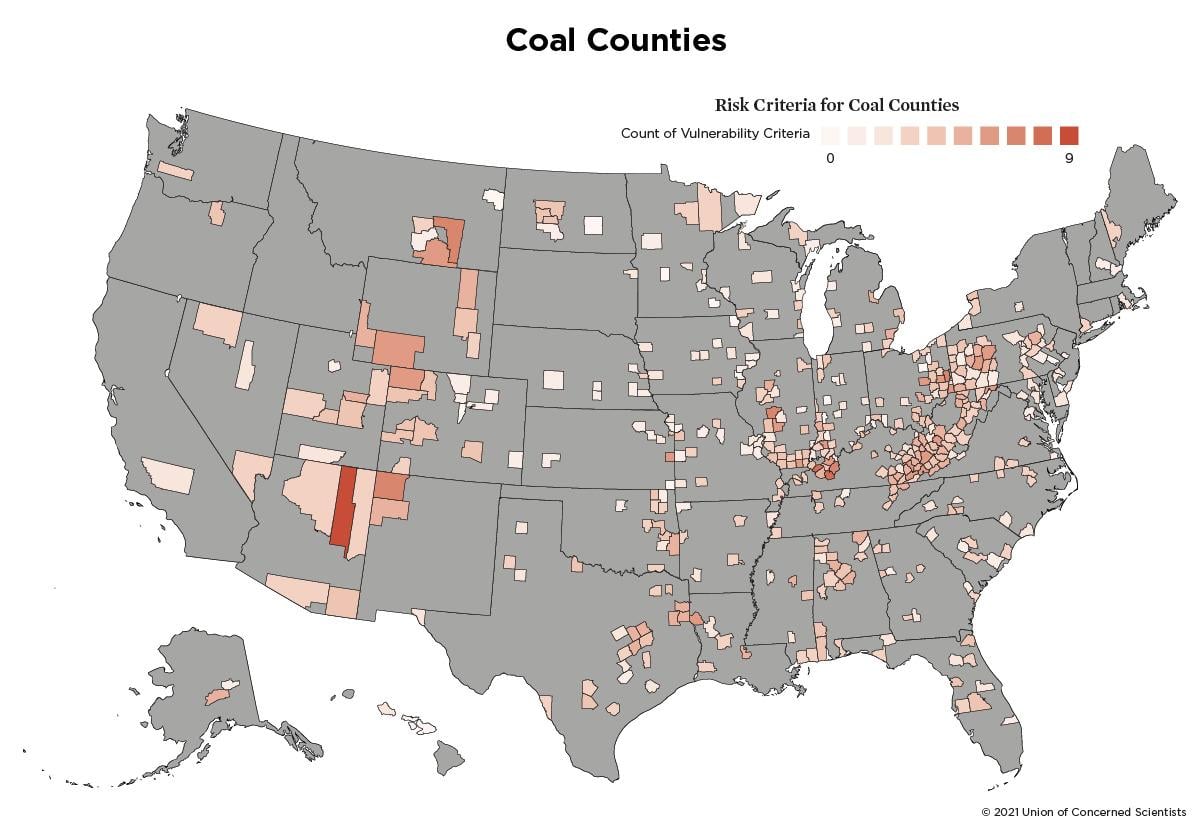
Counties at risk
Based on our definition of a coal county and the 10 risk criteria for evaluating the severity of the economic fallout from coal’s decline, we created a map showing the regions of the country that have been or may be hardest hit (see Figure 2). Navajo County, Arizona, meets nine of the 10 risk criteria, the most of any county nationally. Two counties—Muhlenberg and Webster counties in Kentucky—meet eight of the criteria. Five additional counties meet seven criteria: Sangamon County, Illinois; Ohio County, Kentucky; Rosebud County, Montana; San Juan County, New Mexico; and Jefferson County, Ohio. In all, 28 counties meet at least six criteria, 74 counties meet at least five, and 163 counties meet at least four. Only 14 counties of those we identified as coal counties do not meet any of the criteria.
The 28 counties that met at least six criteria are listed in Table 2. Of these counties, 26 were either above the national average for five-year average unemployment rate or five-year average poverty rate, 26 saw a decline of at least 10 percent in coal production, 23 had at least 50 people employed by coal mines in 2019, and 20 had at least 50 people employed at coalfired power plants in 2019.
But as Figure 2 illustrates, the impact of the shift away from coal will be felt nationwide, rather than limited to the counties where coal is most concentrated. Coal mining tends to be concentrated in a few regions of the country, including Appalachia, the Powder River Basin, the Illinois Basin, and tribal lands in the Southwest. Many of these places are rural and isolated, meaning that the coal mine is the only opportunity for well-paying jobs in the area and that many other businesses in the community either support mining activities or depend on coal miners as customers. Coal-fired power plants, on the other and, are more geographically dispersed. The closure of coal plants, particularly the larger power plants located in more rural areas, result in a significant portion of job losses and lost tax revenue that supports county services.
Coal-fired power plants, on the other hand, are more geographically dispersed. The closure of coal plants, particularly the larger power plants located in more rural areas, result in a significant portion of job losses and lost tax revenue that supports county services.
A call for an intentional vision
Although workers and communities have suffered and are facing an uncertain future as the coal industry declines, solutions are readily available with bold and visionary action from policymakers. Comprehensive solutions include long-term individual supports and benefits for dislocated workers, longterm investments in community infrastructure, empowering local leadership to drive place-based solutions, and ensuring that the legacy of coal mines and coal-fired power plants is fully cleaned up. These elements are critical to a fair, just, and equitable shift to a low-carbon economy, and it will take decades of robust and sustained investment.
A comprehensive set of systemic supports is needed for workers who lose their jobs as a result of the decline in the coal industry. At a minimum this includes: five years of comprehensive wage replacement; guaranteed health care coverage; continued employer contributions to retirement funds or pension plans (that recognize time of service); robust education opportunities including paid tuition for academic, vocational, and other programs; job placement assistance; access to social services; and potential relocation allowances (BGA 2019; JTF 2020). This analysis develops for policymakers an initial ballpark estimate of the cost of supporting these future dislocated workers in finding new jobs with family-sustaining wages and the ability to join a union, as well as support for workers who have already lost their jobs in recent years. In total, the cost of these supports ranges from approximately $33 billion over 25 years to $83 billion over 15 years, a small fraction of the money that will be invested in the energy system in the coming decades as we shift to a low-carbon economy. This is only a down payment, however, as more support will be needed for communities to clean up legacy issues and invest in economic diversification.
Much has been said and written about coal in the last decade—especially over the last four years, when a theme has been bringing back coal jobs. But the industry, and the jobs and economic activity that it supports, has reached a moment of reckoning. The reality is that coal will not return to its heyday; the industry will continue its decline simply because cheaper and cleaner technologies are widely available and rapidly scaling. As the energy mix changes, rather than offer false hope for reinvigorated coal markets, we must acknowledge that thoughtful and intentional planning and comprehensive support are critical to honoring the workers and communities that have sacrificed so much to build this country. The fact is that this shift is already happening, largely without any intentionality at all, leading to devastating consequences for families and communities. We owe far more to those who have given us so much.
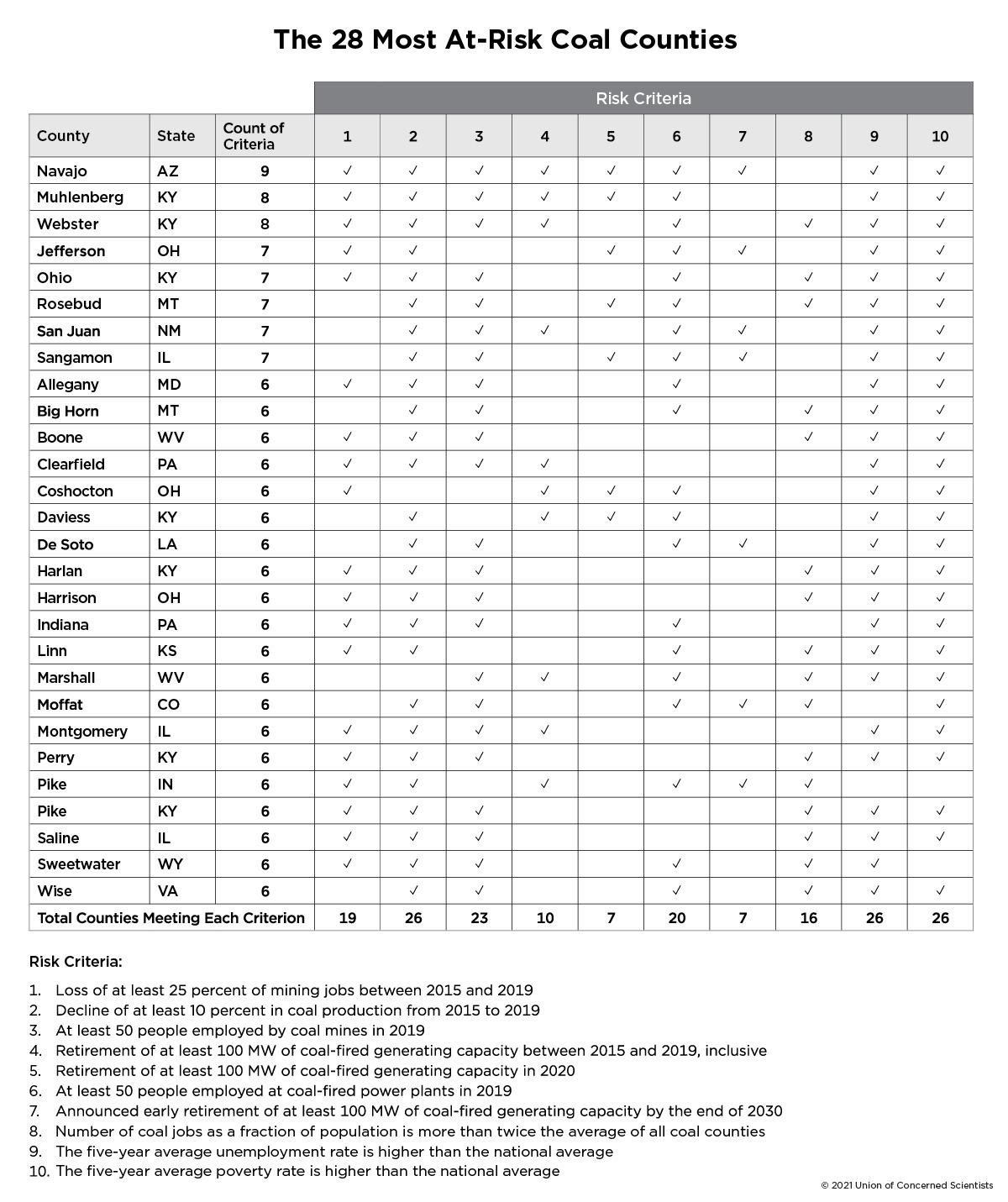
This is a condensed, online version of the report. For all figures, references, and the full text, please download the PDF.
Downloads
Citation
Richardson, Jeremy, Lee Anderson. 2021. Supporting the Nation’s Coal Workers and Communities in a Changing Energy Landscape. Washington, DC.: Union of Concerned Scientists. www.ucsusa.org/resources/support-coal-workers
